Best Cooked Sweet Plantains Recipe in 10 Minutes (Whole30 Friendly)
This sweet plantains recipe is perfect whenever you are looking for a side dish. These sweet plantains are the ultimate choice.
They are sweet and crispy, yet soft and tender.
The sweet taste pairs well with any kind of savory main course. And I have other good news. This dish is healthy and fits a lot of well-known diets, like paleo, Whole30, vegan, sugar free, refined oil free. It is impossible not to like it.
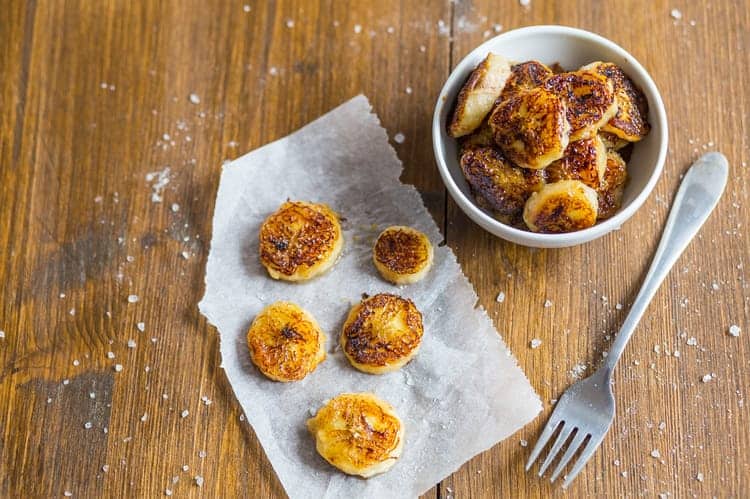
If you are like me, you sure have asked yourself some time ago what are those giant bananas. The first time I saw those, I was convinced that they were a different type of banana.
Well, they are! T
hey belong to the same family but the taste is completely different. Only the ripest plantains can be eaten raw.
Green plantains have a taste similar to potatoes.
The fruits that are riper become caramelized when cooked and taste sweet and delicious. But where do plantains come from?
Short History of Plantains
It is said that plantains originated in South-East Asia and traces can be found as early as 500 B.C. they were mostly found in Malaysia and today’s Indonesia. Traders brought the fruit to India.
We were lucky to have Alexander the Great who wanted to conquer all the world. Around 327 B.C. he discovered this fruit and took it to Europe. Plantain reached from Malaysia to Madagascar due to the trading merchants from Asia and to the Arabs who travelled there during the Trans-Saharan trade expansion. Bantu Kingdom from central and southern Africa thrived around 1500 AD due to the plantains, bananas, yams and other food crops.
The kingdom expanded and these fruits and veggies were used for trade. Even nowadays plantain is largely consumed in Uganda and all the regions that belonged to Bantu kingdom.
In the 15th century, Portuguese exploring western Africa came in contact with banana and started to cultivate it back home. Friar Tomas de Berlanga, a Spanish missionary, took plantains to the Canary Islands. Real soon, banana crops began to spread to Haiti, Mexico and the rest of South America.
In the beginning the farmers cultivated only plantains. The sweet banana was discovered in 1836 by a Jamaican plantation owner, Jean Francois Poujot. After tasting it and noticing the remarkable sweetness, he began to cultivate this variety and soon it made its way to North America.
We often use the word “banana” to describe all the varieties. This is not the right term. The generic name is “plantain” and we have terms for all the types of plantain: cooking plantain, banana plantain, bocadillo plantain. They are all members of the genus Musa.
Plantain is used for cooking while its sweet sister is known as the dessert banana. Even the leaves of the plantain are used in certain cultures. For example, in Venezuela, people utilize the leaves as plates for Venezuelan Hallacas.
South Indian Thali is also served on plantain leaves. Besides from the practical use, the leaves give a delicate but well defined aroma to the dish. You may find them in open markets or grocery stores in Venezuela. They are really large, some exceeding two meters in length.
When you place hot food on the leaves, they release a fragrant smell. Locals say this aroma stimulates the appetite. Nicaragua inhabitants also use them to wrap various dishes, such as Vigoron, Nacatamales or Vaho.
For example, Vigoron consists of fried pork skin accompanied by onions, tomatoes and pickled cabbage served on sweet plantain leaves.
People from Columbia, Honduras and other islands in the Caribbean employ the leaves to wrap their tamales prior and during the cooking process. They also wrap meat cuts they want to season. Leaves keep the flavors inside and help in tenderizing the meat during the cooking process.
Plantain is the main food source in the Dominican Republic. The fruits are used on a large scale in many dishes such as Sancocho and Mangu, some very popular foods. The use of plantain is equal or even larger than the one of rice so you will find many ripe plantain recipes in there.
Banana and plantain leaves look pretty much the same. However, the plantain ones are bigger and more sturdy. Locals smoke them lightly over an open fire. This increases their durability but also the flavor they bring to meats and other dishes.
The plantain makes fruits only one time per season. After the farmers harvest the fruits, they cut the plant and peel all the layers until they get a soft cylinder. They don’t throw it away because it turns into a delicious dish after being steamed and fried with masala powder.
General Information about Plantains
Cooking plantains have a lower sugar content than bananas and contain more starch, that is why they resemble potatoes so much.
When they are green or under ripe the starch load is higher. When they become yellow, the fruits get a certain sweetness. They are enjoyed extensively in the tropical region and play a role similar to the one of potatoes. Partially because they have almost the same neutral texture and flavor when they are not ripe.
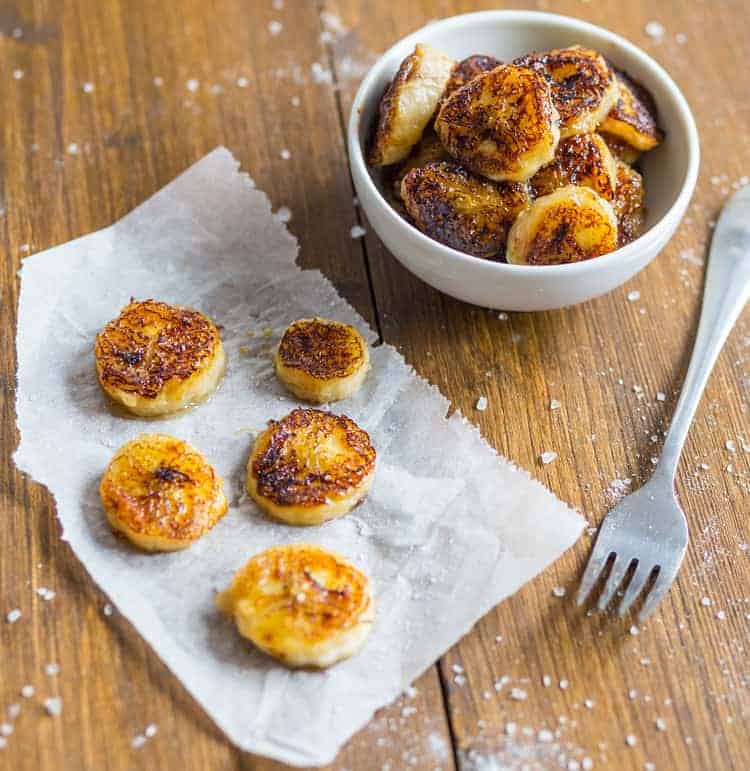
You can find plantain crops in many regions, such as the Caribbean, Florida, Madeira, Canary Islands, Egypt, southern Brazil, southern Taiwan, southern Japan, Colombia. The last one is the largest exporter to the United States.
Just like they fruit, the plantain plants will only flower once too. The flowers will grow in separate bunches at the end of the shoot. Not all the flowers become fruits, only the first few bunches. But nothing is wasted. The flowers that do not turn into fruits are used for cooking. They are chopped, seasoned with masala powder and fried. Vietnamese use the flowers in salads. In Laos, they make vermicelli soup with plantain flower.
People of Ethiopia also utilize the root stock which holds the leaves. Just before the flowering season, it is soft and starchy. They use the shoots of more varieties to cook and eat and those became a great food source.
How to Make This Sweet Plantains Recipe?
There are plenty sweet plantains recipes. The most two common ways of cooking plantains is to bake or fry them. These days they are a popular food in many regions in Africa and also in the Caribbean. It doesn’t matter if a sweet plantain is green, a little ripe or very ripe.
We can use it for cooking in any moment. Very ripe plantains can be also enjoyed raw. The color changes as the fruit ripens. It turns from green to yellow, brown and black, following the same path as its sweeter sister, dessert banana. Green plantains contain a lot of starch and are very firm. The yellow, brown and black are softer and sweeter.
Extremely ripe plantains are the softest and the sweetest (that's why this is a sweet plantains recipe). That is why they are used for sweet dishes. Ripe plantain recipes call for yellow to dark fruits. In case you want to feed them to babies, there is always the option to steam them.
Being very nutritious, sweet plantains make a great meal for small children and even older people. Doctors consider that they are easier to digest than bananas so mashing them will give you a delicious option for your baby’s lunch.
Plantains contain a lot of vitamin C and have the largest amount of potassium amongst any fruit and vegetable. The levels of riboflavin (vitamin B2) is also high.
Even if it is a food high in starch, cooking plantain is suitable for Whole30 diet which involves eating only fruits, veggies, organic meats, eggs, good fats, nuts and seeds for thirty days.
How to Fry Sweet Plantains?
Many sweet plantains recipes require frying. Plantains can be fried just like any other fruit or vegetable. You will need some fat, like butter or oil to do that. If you want to make your sweet plantains Whole30 friendly, you should know that the accepted fats are coconut oil, olive oil or ghee (clarified butter).
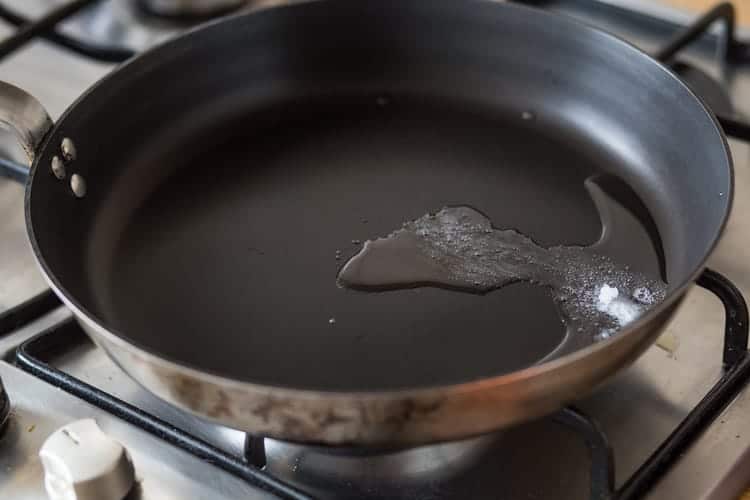
Cut the fruit in thick slices. Melt the butter or whatever you’re using and place the slices into the pan. Fry until golden brown and flip over. Make sure you keep some space between the slices so they don’t stick one to another.


How to Prepare Plantains?
In order to peel the fruit before making a plantain recipe, you need to bring it to room temperature. If you store it in the fridge the fruit will be harder to peel.
But every now and then, time is the one element missing when we are getting ready to cook. So in case you don’t have enough time to wait for the plantain to warm, soak it in hot tap water.
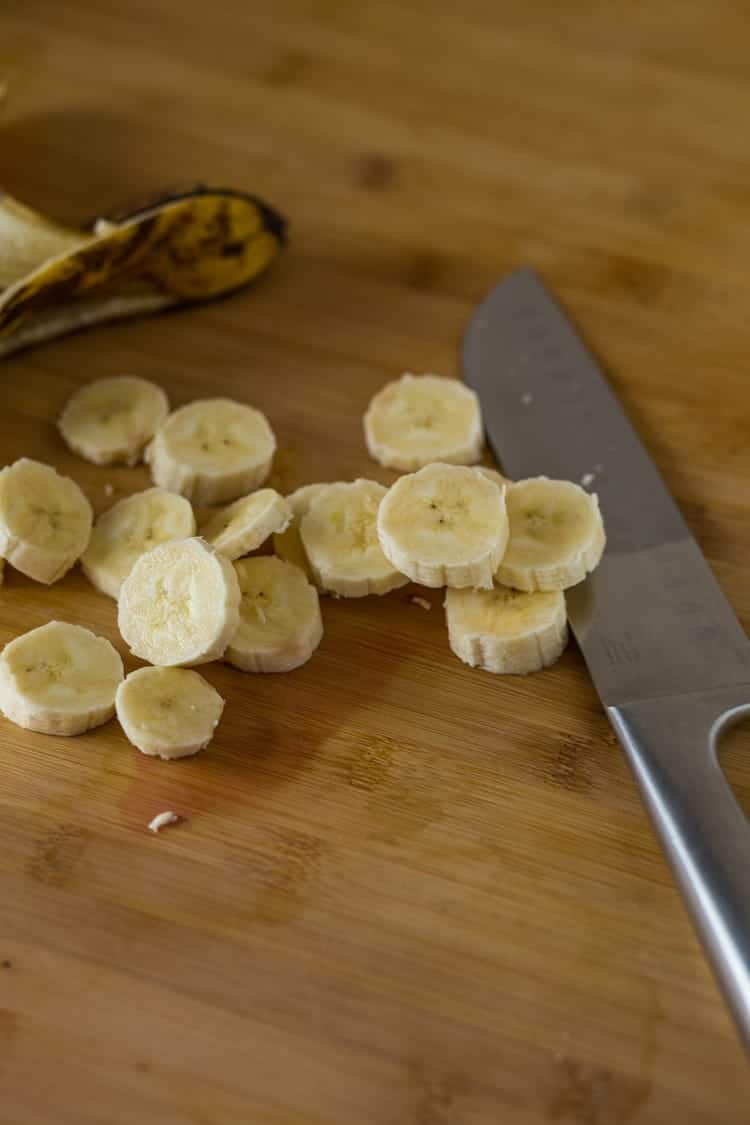
Place the fruit on a cutting board and trim off the ends. Hold the plantain in your hand and use the tip of a sharp knife to cut the peel along the length of the fruit. If the plantain is not ripe at all, you might need to insert the knife under the peel to lose it a bit.
To remove the peel, take it off side to side rather than doing it lengthwise. Depending on its ripeness, it will be easier or harder for you to peel the plantain.
The green fruits have stiff peel, the ripe ones have it pliable. After peeling, you are ready to cook the sweet plantains recipe.
How to Serve This Sweet Plantains Recipe?
In my opinion, the best ripe plantain recipes are the ones which just require to fry them and add a dash of salt. The slices are a bit crispy on the outside but soft on the inside. I usually eat them directly from the pan and burn my tongue. I strongly advise you not to try this at home.

However, there are plenty of recipes out there. They fit just about any dish, from steaks to salads and lasagna. They can be fried, baked or steamed. Cooking plantains go well with cheesy sauces, rice, vegetables and pasta. They pair with almost anything.
What Pan Should I use for Frying the Sweet Plantains?
I personally prefer nonstick stainless steel pans. The sugar content in plantains is pretty high so they will tend to stick to the bottom of your pan.
When using a cast iron skillet, make sure you add enough fat so that the plantain slices won’t remain glued.
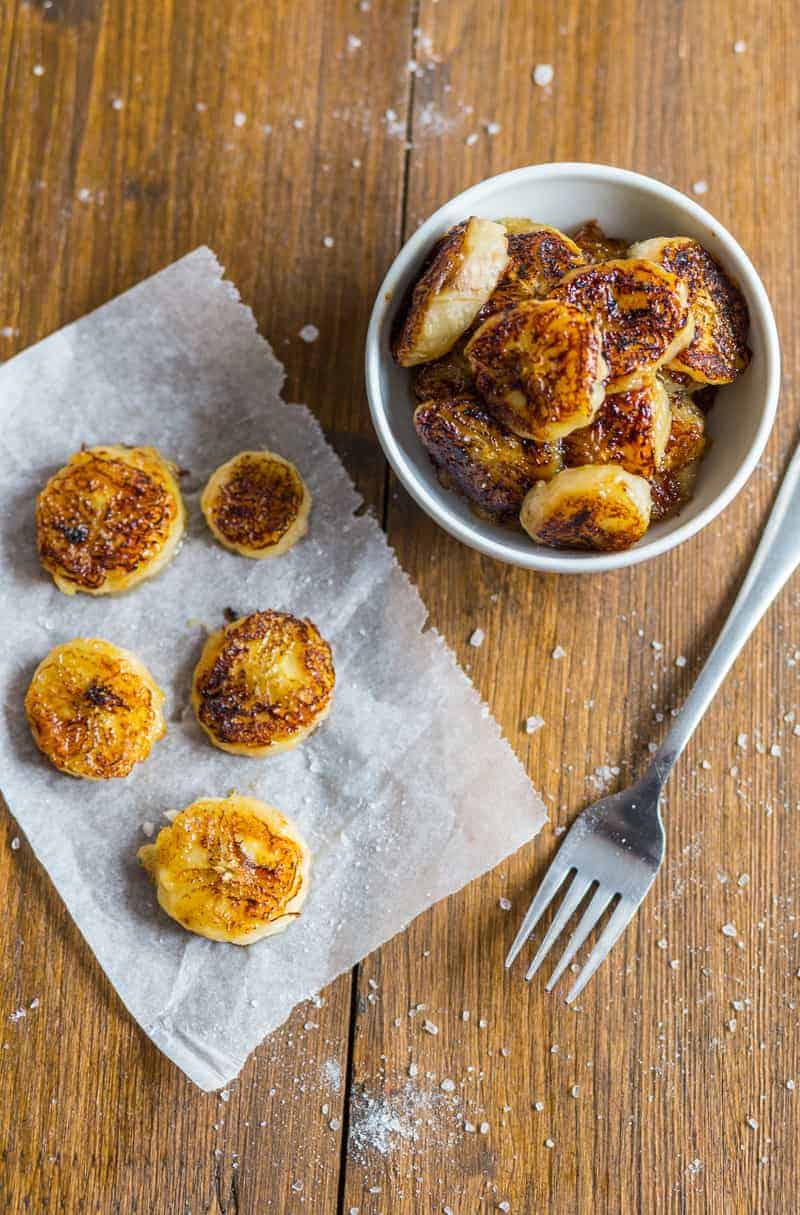
Equipment
- Stove
Ingredients
- 1 pcs large very ripe plantain
- 2 tbsp coconut oil
- Salt to taste
Instructions
- Cut off the ends of the plantain. Use the tip of the knife to score the fruit lengthwise. The skin should drop easier this way. Peel the plantain and cut it into thick slices.
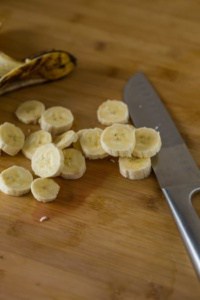
- Melt the coconut oil in a large pan. We use coconut oil to make the recipe Whole30 friendly.
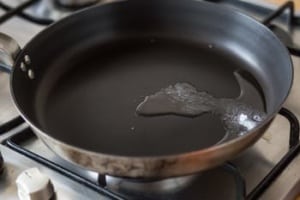
- Make sure the oil is hot before adding the plantain slices.
- Bring in the fruit and make sure the slices don’t touch each other. Due to the high sugar content, they may get stuck.
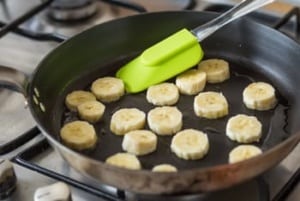
- When the bottom of the slices is golden brown, flip them over. Use a spatula or the back of a fork to flatten them a bit. You may want to reduce the heat so they don’t get burnt.
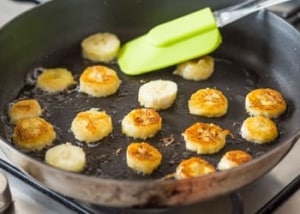
- Remove the slices from the pan, sprinkle the salt and enjoy right away!
Notes
- I strongly recommend that you eat the fried plantains right after you take them out of the pan. Maybe wait for a minute or two so you don’t burn your tongue like I usually do. But they taste best in those minutes when they are warm. You may enjoy them later too but I found out that the taste is completely different.
- Adjust the plantain quantity in case you have guests, everyone will want to eat those goodies. If my kids like fried plantains, then probably most people do. Did I mention that my children are some kind of picky eaters? Just like all other children out there? So, if they enjoy those sweet bites, then you should give them a try too.
